When talking about image clarity, it is crucial to take into account picture spacing, which is the gap between the midpoint of one picture element to the center of the next pixel. A reduced pixel spacing yields a higher resolution, allowing for more detail in the visuals displayed. For example, an LED wall with a picture spacing of 1.5mm will provide a clearer image than one with a pixel pitch of 3mm. This is particularly crucial in environments where viewers are close to the display, such as in a compact location or a exhibition event booth. In these cases, a higher image clarity can greatly improve the viewing experience.
Another aspect of image clarity is its impact on hue accuracy and brightness. LED walls with higher image clarity often have better color rendering, indicating that the click resources hues displayed are more vibrant and realistic. This is essential for uses like advertising, where the goal is to attract interest and communicate a concept effectively. Additionally, higher resolution screens can maintain brightness levels even when seen from various perspectives. This is important in large venues where audiences may be seated at different distances and positions from the display.

The performance of LED screens is also affected by image clarity in terms of refresh rates and response times. A higher image clarity display can handle faster update rates, which is essential for fast-moving material such as videos and animations. This means that the images on the screen will appear smoother and more fluid, enhancing the total viewing experience. In contrast, reduced image clarity screens may struggle with fast-moving content, leading to blurriness or lag. Therefore, for events that rely on high-energy visuals, selecting a screen with a suitable image clarity is vital.
In summary, image clarity plays a crucial role in defining the functionality and image clarity of LED screens. Factors such as pixel pitch, color accuracy, brightness, update frequencies, and reaction durations all affect how efficiently a screen can convey information and engage viewers. As technology continues to advance, understanding these elements will help operators choose the appropriate LED wall for their particular requirements, guaranteeing that they achieve the best possible outcomes in their displays and occasions.